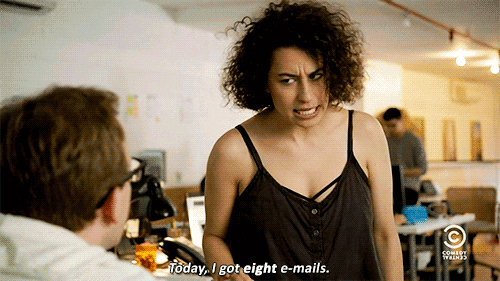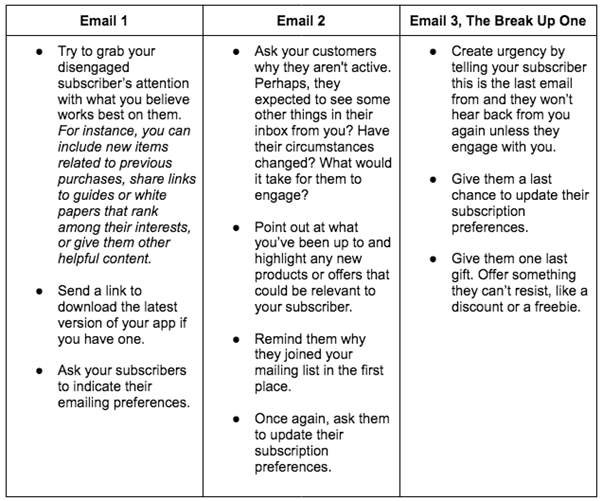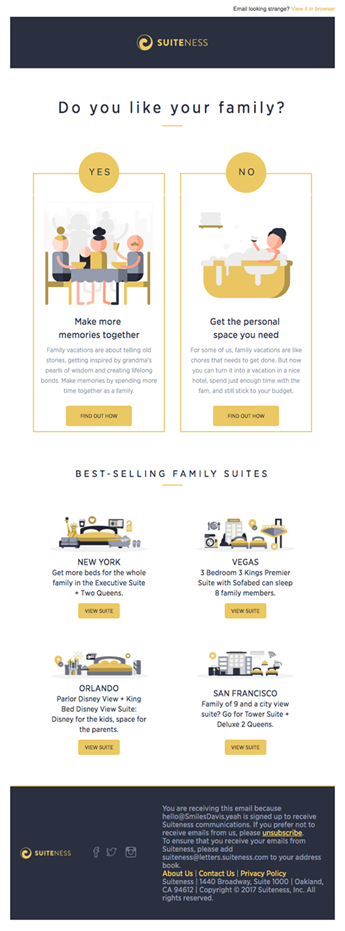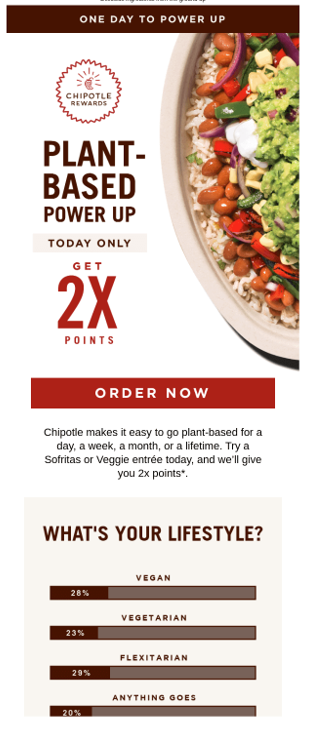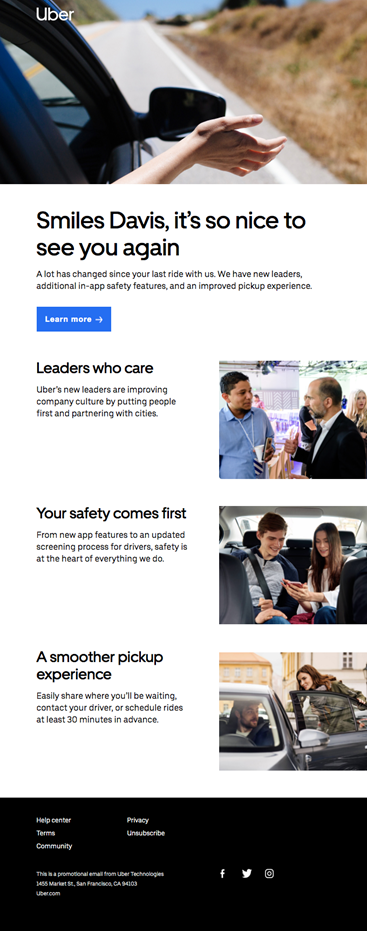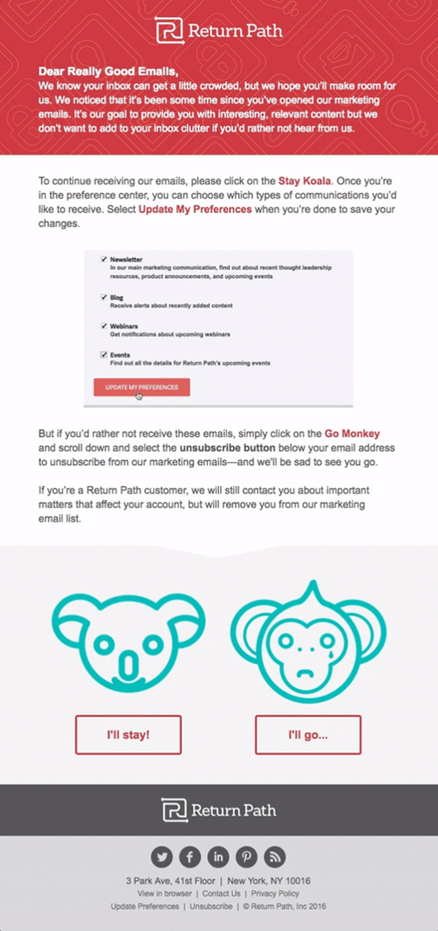Hey, have you been...distanced lately? Not that we noticed haha. I mean, was it something we did? Something we said?
Because we can't picture our sad, sad lives without you. Did we come across too strong? Please come back. Here's 10% off some frozen yogurt after with three purchases.
Businesses lose a fourth of their email list volume every year. So, to avoid churn, your list has to be managed correctly. Starting with chopping at those disengaged subscribers.
Drop in engagement = Poor Reputation = Lower Deliverability
45% of subscribers who receive a win-back email actually take interest in reading the messages from the brand. So, what makes for a good re-engagement email?
I mean, that's what you're here for, right? That, and the pug pics.
So, there tends to be three different types of re-engagement email, in chronological order, put into a handy graph here by Nethunt:
So, let's start with a top tier example of Email 1, from Netflix.
1. Netflix
Netflix doesn't just collect data about the shows its users watch. It also uses that data to create further interaction.
And this technique doesn't stop at emails. These examples might look mighty complicated, but they're actually pretty simple; you can see their suggestions, and play them right then and there, on whichever device you might be on.

So customers are getting personalised recommendations, and then an immediate lead, plus Netflix gets to make better suggestions for what a client might choose in the future. Win-win. Win.
Netflix also does a bunch of split tests. Up to a couple hundred a year in fact. It'll randomly select 300,000 users, and tests everything from images, to font size.
2. Suiteness
As in the Netflix email, Suiteness doesn't rely on words alone to engage recipients. Using clearly identifiable logos, and attractive images, they communicate their message in a classic 'show, don't tell' kind of way.
Suiteness has also used a number of different techniques in these two examples, including:
- Step One: Using Humour. Humour can be an amazingly effective way to gain, and keep, interest. It's a light-hearted way of encouraging re-engagement, whilst communicating your distinct voice as a brand.
- Step Two: Using Gamification. Gamification takes the elements of gaming, and uses it in ways that aren't necessarily related. This might be
- badges, leader boards, or
- avatars. Suiteness uses gamification in a more subtle way, with a 'choose-your-own-adventure' story type interface. This can be used as an almost extension of using humour, while getting your client to engage directly with the email copy.
- Step Three: Noting Customer Preference. Just like Netflix, Suiteness isn't just encouraging re-engagement, but collecting data on how to prevent lack of engagement in the future. With just a click, they can gather this info, and direct them to the site.
3. Chipotle
Chipotle seems to have gotten the customer appreciation emails down to a T.This type of re-engagement email is usually used with warm leads, discouraging them from turning cold.
Chipotle seems to have gotten the customer appreciation emails down to a T.
This type of re-engagement emails are usually used with warm leads, discouraging them from turning cold.
Companies tend to send customer appreciation emails to keep subscribers happy, and keep the brand fresh in their minds.
These emails help strengthen and maintain customer connections and relationships, and re-engage clients in times when they start to lose a little bit of interest in the brand. Remember, retaining customers is cheaper and easier than attracting new ones.

Chipotle has also personalised these emails for each subscriber. The first example even shows the customer's previous interactions with the brand, whilst the second is a more standard birthday message.
Both encourage an additional purchase, to make use of a limited time deal. OmniSend suggest that the open rate for birthday emails is 45% with a conversion rate of 3% - it's all about offering a limited, and exclusive, deal as a trade-off for your customer's attention and time.
4. Uber
Uber's re-engagement email features everything an AWOL customer might've missed, catching them up to speed with the company, and the companies new features.
If you're looking at the table at the beginning of this article you'll see this is an example of email number two: "point out what you've been up to and highlight any new products or offers that could be relevant to your subscriber."
"We miss you" emails are particularly effective , if you don't mind doling out a bit of a guilt-trip. Rather than calling out someone for being inactive, it feels a little bit more polite, indicating that we're not mad, we're just disappointed. It shows the brand cares about customers that haven't returned back.
Plus, Uber is showing the benefits their company offers, and addresses any pain points the inactive customer might have with the brand.
But what Uber does particularly well is the simple flow it follows.
1) They tell the person why they're emailing - "A lot has changed since your last ride with us"
2) They then remind them of what makes the brand useful and unique - "Leaders who care...Your safety comes first...A smoother pickup experience"
3) They also encourage re-engagement, with a CTA to find out more ine - "Learn more"
5. ReturnPath
This one is all about finding out the problem why customers aren't engaging.
Asking a question, at the right time, can help clients re-engage. This might be through linking a customer survey, or by addressing pain points underneath the question.
Even a simple version of the 'break-up' email (or email 3 in the chart), can be effective. Take this Framebridge one, for example:
It's basically just a yes or no question, then a nice, bright orange button. Simple and direct.
It's important to keep these kind of emails conversational, and easy to process. The subject line should also make it clear this isn't just another marketing email.
ReturnPath use humour alongside their unsubscribe buttons, offering the choice of a "Go Monkey", or a "Stay Koala". This works alongside the conversational element, but also makes sure the unsubscribe button is visible.
Though a highly visible unsubscribe button might seem counterintuitive, it works well as a re-engagement strategy. Showing your customers their opinion is valued, and offering them a choice, means they don't feel inundated with emails, or unheard in their complaints. Plus, with GDPR, it's illegal not to, so there's that.
It also shows a customer what they'll be missing otherwise. Research shows that people pay more attention to what we might lose, than what we might gain. So if there's a chance a customer might be worse off, they'll choose that Stay Koala asap.
